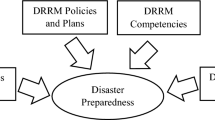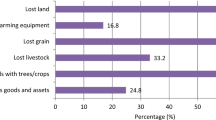Abstract
Tsunamis are some of the most destructive types of natural hazards that can affect coastal areas. To optimize tsunami mitigation measures, it is important to estimate the potential casualties that can result from one of these events. Taking into account tsunami awareness and the possible evacuation behavior of at-risk individuals is necessary to estimate the number of casualties, though most of the research carried out to date has not considered detailed evacuation behavior when conducting simulations. In the present study, the authors proposed a new approach to estimating the number of tsunami casualties, based on a tsunami evacuation simulation model that considers the evacuation behavior of local residents, tourists and beach users. Such behavior parameters were incorporated by analyzing the results from previous questionnaires surveys. The model was applied to Yuigahama Beach in Kamakura City, Japan, with the aim of assessing potential tsunami casualties and providing suggestions regarding tsunami mitigation measures. The authors conducted seven tsunami inundation simulations for different earthquake scenarios, and then casualties were estimated considering six different evacuation scenarios. Based on the simulation results, it appears particularly important to attempt to improve the intended evacuation behavior of both the local population and visitors. Particularly, providing information about safe places and the routes to reach them is necessary, as prompt evacuation and heading to higher ground were found to be insufficient behavior to save lives during a tsunami event.















Similar content being viewed by others
References
Bricker JD, Gibson S, Takagi H, Imamura H (2015) On the need for larger Manning’s Roughness coefficients in depth-integrated tsunami inundation models. Coast Eng J 57(2):1550005
Carey N (2005) Establishing pedestrian walking speeds. Project Report, Portland State University, ITE Students Chapter
Carlos-Arce RS, Onuki M, Esteban M, Shibayama T (2017) Risk awareness and intended tsunami evacuation behavior of international tourists in Kamakura City, Japan. IJDRR 23:178–192. https://doi.org/10.1016/j.ijdrr.2017.04.005
Cox RJ, Shand TD, Blacka MJ (2010) Australian rainfall and runoff revision projects project 10: Appropriate safety criteria for people. http://arr.ga.gov.au/__data/assets/pdf_file/0006/40578/ARR_Project_10_Stage1_report_Final.pdf. Accessed 10 June 2017
De Risi R, Goda K (2016) Probabilistic earthquake-tsunami multi-hazard analysis: application to the Tohoku Region, Japan. Frontiers in Built Environment 2:25. https://doi.org/10.3389/fbuil.2016.00025
Di Mauro M, Megawati K, Cedillos V, Tucker B (2013) Tsunami risk reduction for densely populated Southeast Asian cities: analysis of vehicular and pedestrian evacuation for the city of Padang, Indonesia, and assessment of interventions. Nat Hazards 68(2):373–404. https://doi.org/10.1007/s11069-013-0632-z
Dijkstra EW (1959) A note on two problems in connection with graphs. Numer Math 1:269–271
Dohi Y, Okumura Y, Koyama M, Kiyono J (2015) Evacuee generation simulation of the 2011 Tohoku tsunami in Kadonowaki, Ishinomaki. J Japan Soc Civil Eng Ser A1 (Struct Eng Earthq Eng) 71(4):823–831 (in Japanese)
Enomoto T, Takanashi N, Ochiai T (2015) Research for enforcement of tsunami evacuation measures in the historical tourist city, Kamakura, based on findings by surveys. J Soc Saf Sci 27:1–10 (in Japanese)
Esteban M, Tsimopoulou V, Nistor I, Mikami T, Yun NY, Suppasri A, Shibayama T (2013) Recent tsunamis events and preparedness: development of tsunami awareness in Indonesia, Chile and Japan. IJDRR 5:84–97. https://doi.org/10.1016/j.ijdrr.2013.07.002
Esteban M, Onuki M, Ikeda I, Akiyama T (2015) Reconstruction following the 2011 Tohoku earthquake tsunami: case study of Otsuchi town in Iwate prefecture, Japan. In: Esteban M, Takagi H, Shibayama T (eds) Handbook of coastal disaster mitigation for engineers and planners. Butterworth-Heinemann (Elsevier), Oxford, UK, pp 615–630
FEMA (2008) Guidelines for design of structures for vertical evacuation from tsunamis. Federal Emergency Management Agency P604, Washington
Freire S, Aubrecht C, Wegscheider S (2013) Advancing tsunami risk assessment by improving spatio-temporal population exposure and evacuation modeling. Nat Hazards 68(3):1311–1324. https://doi.org/10.1007/s11069-013-0603-4
Fruin JJ (1971) Pedestrian planning and design. Metropolitan Association of Urban Designers and Environmental Planners, New York
Headquarters for Earthquake Research Promotion (2015) Summary of long-term evaluation for subduction-zone earthquake. http://www.jishin.go.jp/main/choukihyoka/kaikou.htm. Accessed 25 April 2016
Hori M, Susumu T, Araki H, Okumura Y, Dohi Y (2015) Verification and validation of tsunami evacuation simulation models. J Japan As Earthq Eng 15(5):144–157 (in Japanese)
Japan Meteorological Agency (2013) Tsunami warning/advisory and tsunami information. http://www.data.jma.go.jp/svd/eqev/data/en/guide/tsunamiinfo.html. Accessed 28 July 2017
Jelinek R, Krausmann E, Gonzalez M, Alvarez-Gomez JA, Birkmann J, Welle T (2012) Approaches for tsunami risk assessment and application. Nat Hazards 60(2):273–293. https://doi.org/10.1007/s11069-011-0009-0
Jonkman SN, Kok M, Vrijing JK (2008) Flood risks assessment in the Netherlands: a case study for dike ring South Holland. Risk Anal 28(5):1357–1373. https://doi.org/10.1111/j.1539-6924.2008.01103.x
Kamakura City Office (2015a) Summary of the census in Kamakura City. https://www.city.kamakura.kanagawa.jp/soumu/toukei/27kokucyokekka.html. Accessed 05 June 2017
Kamakura City Office (2015b) Tsunami evacuation plan for Kamakura City. https://www.city.kamakura.kanagawa.jp/sougoubousai/documents/01-1tunamikeikaku.pdf. Accessed 05 July 2017
Kamakura City Office (2016) Press release issued on 2016/09/06. https://www.city.kamakura.kanagawa.jp/kamakura-kankou/documents/hp.pdf. Accessed 05 July 2017
Kamakura City Office (2017a) Press release issued on 2017/05/01. https://www.city.kamakura.kanagawa.jp/kamakura-kankou/documents/h28irikomi.pdf. Accessed 05 July 2017
Kamakura City Office (2017b) Survey for tourism in Kamakura City. https://www.city.kamakura.kanagawa.jp/kankou/kankoujijouh28.html. Accessed 05 July 2017
Kanagawa Prefecture (2012) Manual of new tsunami hazard map. http://www.pref.kanagawa.jp/uploaded/life/1017806_3355937_misc.pdf. Accessed 01 April 2017
Kotani M, Imamura F, Shuto N (1998) Tsunami run–up simulation and damage estimation by using geographical information system. Proc Coastal Eng 45:356–360 (in Japanese)
Koyanagi Y, Arikawa T (2016) Study of the tsunami evacuation tower using the tsunami evacuation simulation. J Japan Soc Civil Eng Ser B2 (Coast Eng) 72(2):1567–1572 (in Japanese)
KOZO KEIKAKU ENGINEERING Inc. (2016) Handbill of artisoc. http://mas.kke.co.jp/cabinet/artisoc_handbill2016-en.pdf. Accessed 27 July 2017
Kumagai K (2014) Validation of tsunami evacuation simulation to evacuation activity from the 2011 off the pacific coast of Tohoku earthquake tsunami. J Japan Soc Civil Eng Ser D3 (Infrastruct Plann Manag) 70(5):187–196 (in Japanese)
Makinoshima F, Imamura F, Abe Y (2016) Behavior from tsunami recorded in the multimedia sources at Kesennuma City in the 2011 Tohoku tsunami and its simulation by using the evacuation model with pedestrian–car interaction. Coast Eng J 58(4):1640023. https://doi.org/10.1142/S0578563416400234
Manshinha L, Smylie DE (1971) The displacement fields of inclined faults. Bull Seismol Soc Am 61(5):1433–1440
Mas E, Suppasri A, Imamura F, Koshimura S (2012) Agent-based simulation of the 2011 Great East Japan Earthquake/Tsunami evacuation: an integrated model of tsunami inundation and evacuation. J Nat Disaster Sci 34(1):41–57. https://doi.org/10.2328/jnds.34.41
Mas E, Koshimura S, Imamura F, Suppasri A, Muhari A, Adriano B (2015) Recent advances in agent-based tsunami evacuation simulations: case studies in Indonesia, Thailand, Japan and Peru. Pure Appl Geophys 172(12):3409–3429. https://doi.org/10.1007/s00024-015-1105-y
Mikami T, Shibayama T (2016) What makes people evacuate? Triggers for tsunami evacuation. In: Proceedings of the 9th international conference on coastal and port engineering in developing countries (COPEDEC), Rio de Janeiro, Brazil
Mori N, Goda K, Cox DT (2018) Recent progress in Probabilistic Tsunami Hazard Assessment (PTHA) for mega thrust subduction earthquakes. In: Santiago-Fandino V, Sato S, Maki N, Iuchi K (eds) The 2011 Japan earthquake and tsunami: reconstruction and restoration insights and assessment after 5 years, vol 47. Springer, Cham, pp 469–485. https://doi.org/10.1007/978-3-319-58691-5_27
Mostafizi A, Wang H, Cox D, Cramer LA, Dong S (2017) Agent-based tsunami evacuation modeling of unplanned network disruptions for evidence-driven resource allocation and retrofitting strategies. Nat Hazards 88(3):1347–1372. https://doi.org/10.1007/s11069-017-2927-y
Murakami H, Takimoto K, Pomonis A (2012) Tsunami evacuation process and human loss distribution in the 2011 Great East Japan Earthquake: a case study of Natori City, Miyagi Prefecture, 15WCEE, Lisbon, Portugal
National Police Agency of Japan (2016) Damage Report National Police Agency Japan (December 9 2016). https://www.npa.go.jp/archive/keibi/biki/higaijokyo_e.pdf. Accessed 15 July 2017
Nirupama N (2009) Analysis of the global tsunami data for vulnerability and risk assessment. Nat Hazards 48(1):11–16. https://doi.org/10.1007/s11069-008-9243-5
Okumura N, Jonkman SN, Esteban M, Hofland B, Shibayama T (2017) A method for tsunami risk assessment: a case study for Kamakura, Japan. Nat Hazards 88(3):1451–1472. https://doi.org/10.1007/s11069-017-2928-x
Ormerod P, Rosewell B (2009) Validation and verification of agent-based models in the social sciences. In: Squazzoni F (ed) Epistemological aspects of computer simulation in the social sciences. Springer, Berlin, pp 130–140
Park H, Cox DT, Alam MS, Barbosa AR (2017) Probabilistic seismic and tsunami hazard analysis (PSTHA) conditioned on a mega-thrust rupture of the Cascadia Subduction Zone. Front Built Environ 3:32. https://doi.org/10.3389/fbuil.2017.00032
Shibayama T (2015) 2004 Indian Ocean Tsunami. In: Esteban M, Takagi H, Shibayama T (eds) Handbook of coastal disaster mitigation for engineers and planners. Butterworth-Heinemann (Elsevier), Oxford, pp 3–19
Shibayama T, Esteban M, Nistor I, Takgi H, Dahn Thao N, Matsumaru R, Mikami T, Aranguiz R, Jayaratne R, Ohira K (2013a) Classification of tsunami and evacuation areas. Nat Hazards 67(2):365–386. https://doi.org/10.1007/s11069-013-0567-4
Shibayama T, Ohira K, Takabatake T (2013b) Present and future tsunami and storm surge protections in Tokyo and Sagami Bays. In: Proceedings of the 7th international conference on Asian and Pacific Coasts (APAC 2013), pp 764–766
Sugimoto A, Ohtoshi K, Ishigaki T, Shimada H (2011) Attitude survey of beach users’ awareness about gigantic tsunami. J Japan Soc Civil Eng Ser B2 (Coastal Engineering) 67(2):1266–1270 (in Japanese)
Takabatake T, Shibayama T, Esteban M, Ishii H, Hamano G (2017) Simulated tsunami evacuation behavior of local residents and visitors in Kamakura, Japan. IJDRR 23:1–14. https://doi.org/10.1016/j.ijdrr.2017.04.003
Uno Y, Shigihara Y, Okayasu A (2015) Development of crowd evacuation simulation for risk evaluation of human damage by tsunami inundation. J Japan Soc Civil Eng Ser B2 (Coastal Enginering) 71(2):1615–1620 (in Japanese)
Wang H, Mostafizi A, Cramer LA, Cox D, Park H (2016) An agent-based model of a multimodal near-field tsunami evacuation: decision-making and life safety. Transport Res C Emerg 64:86–100. https://doi.org/10.1016/j.trc.2015.11.010
Wood N, Good J (2004) Vulnerability of port and harbor communities to earthquake and tsunami hazards: the use of GIS in community hazard planning. Coast Manag 32(3):243–269
Yamao S, Esteban M, Yun NY, Mikami T, Shibayama T (2015) Estimation of the current risk to human damage life posed by future tsunamis in Japan. In: Esteban M, Takagi H, Shibayama T (eds) Handbook of coastal disaster mitigation for engineers and planners. Butterworth-Heinemann (Elsevier), Oxford, pp 257–274
Yasuda T, Hatayama M, Shimada H (2016) National questionnaire survey of surfers awareness about tsunami evacuation. Saf Sci Rev 2016:61–80 (in Japansese)
Acknowledgements
This work was financially supported by the Strategic Research Foundation Grant-Aided Project for Private Universities from Ministry of Education, Culture, Sports, Science and Technology, MEXT (Waseda University, No. S1311028).
Author information
Authors and Affiliations
Corresponding author
Rights and permissions
About this article
Cite this article
Takabatake, T., Shibayama, T., Esteban, M. et al. Advanced casualty estimation based on tsunami evacuation intended behavior: case study at Yuigahama Beach, Kamakura, Japan. Nat Hazards 92, 1763–1788 (2018). https://doi.org/10.1007/s11069-018-3277-0
Received:
Accepted:
Published:
Issue Date:
DOI: https://doi.org/10.1007/s11069-018-3277-0




